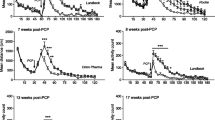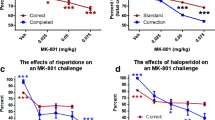Abstract
Rationale
New pharmacological treatments for the cognitive deficits in schizophrenia are needed. Tetrahydroprotoberberines, such as govadine, are one class of compounds with dopaminergic activities that may be useful in treating some aspects of the cognitive symptoms of the disorder.
Objective
The objective of the present studies was to test the effects of the d- and l-enantiomers of govadine on the impairment in a paired-associate learning (PAL) task produced by acute MK-801 in rats. We also assessed effects of the typical antipsychotic haloperidol as a comparator compound.
Methods
MK-801 (0.05, 0.1, 0.15, and 0.2 mg/kg), d- and l-govadine (0.3, 1.0, and 3.0 mg/kg), and haloperidol (0.05, 0.1, and 0.25 mg/kg) were administered acutely to rats well trained on the PAL task in touchscreen-equipped operant conditioning chambers.
Results
Acute MK-801 impaired performance of PAL in a dose-dependent manner by reducing accuracy and increasing correction trials. l-Govadine (1.0 mg/kg), but not d-govadine, blocked the disruptive effects of MK-801 (0.15 mg/kg) on PAL. Haloperidol failed to affect the MK-801-induced disruption of PAL. Higher doses of l-govadine and haloperidol dramatically impaired performance of the task which confounded interpretation of cognitive outcomes.
Conclusion
l-Govadine appears unique in its ability to improve performance of the MK-801-induced impairment in the PAL task. This behavioral effect may relate the ability of l-govadine to antagonize dopamine D2 receptors while also promoting dopamine efflux. Future research should further characterize the role of the dopamine system in the rodent PAL task to elucidate the mechanisms of its pro-cognitive effects.






Similar content being viewed by others
References
Ashby DM, Lapish CC, Phillips AG (2015) Stability of avoidance behaviour following repeated intermittent treatment with clozapine, olanzapine or D, L-govadine. Behav Pharmacol 26:133–138
Banasikowski TJ, MacLeod LS, Beninger RJ (2012) Comparison of nafadotride, CNQX, and haloperidol on acquisition versus expression of amphetamine-conditioned place preference in rats. Behav Pharmacol 23:89–97
Barnett JH, Sahakian BJ, Werners U, Hill KE, Brazil R, Gallagher O et al (2005) Visuospatial learning and executive function are independently impaired in first-episode psychosis. Psychol Med 35:1031–1041
Bethus I, Muscat R, Goodall G (2006) Dopamine manipulations limited to preexposure are sufficient to modulate latent inhibition. Behav Neurosci 120:554–562
Brown AS, Vinogradov S, Kremen WS, Poole JH, Deicken RF, Penner JD et al (2009) Prenatal exposure to maternal infection and executive dysfunction in adult schizophrenia. Am J Psychiatry 166:683–690
Bussey TJ, Holmes A, Lyon L, Mar AC, McAllister KA, Nithianantharajah J et al (2012) New translational assays for preclinical modelling of cognition in schizophrenia: the touchscreen testing method for mice and rats. Neuropharmacology 62:1191–1203
Delotterie DF, Mathis C, Cassel JC, Rosenbrock H, Dorner-Ciossek C, Marti A (2015) Touchscreen tasks in mice to demonstrate differences between hippocampal and striatal functions. Neurobiol Learn Mem 120:16–27
Dix S, Gilmour G, Potts S, Smith JW, Tricklebank M (2010) A within-subject cognitive battery in the rat: differential effects of NMDA receptor antagonists. Psychopharmacology (Berl) 212:227–242
Elvevag B, Goldberg TE (2000) Cognitive impairment in schizophrenia is the core of the disorder. Crit Rev Neurobiol 14:1–21
Floresco SB, Zhang Y, Enomoto T (2009) Neural circuits subserving behavioral flexibility and their relevance to schizophrenia. Behav Brain Res 204:396–409
Fowler SW, Ramsey AK, Walker JM, Serfozo P, Olive MF, Schachtman TR et al (2011) Functional interaction of mGlu5 and NMDA receptors in aversive learning in rats. Neurobiol Learn Mem 95:73–79
Geyer MA, Krebs-Thomson K, Braff DL, Swerdlow NR (2001) Pharmacological studies of prepulse inhibition models of sensorimotor gating deficits in schizophrenia: a decade in review. Psychopharmacology (Berl) 156:117–154
Gilmour G, Dix S, Fellini L, Gastambide F, Plath N, Steckler T et al (2012) NMDA receptors, cognition and schizophrenia—testing the validity of the NMDA receptor hypofunction hypothesis. Neuropharmacology 62:1401–1412
Green MF (2006) Cognitive impairment and functional outcome in schizophrenia and bipolar disorder. J Clin Psychiatry 67:e12
Homayoun H, Stefani MR, Adams BW, Tamagan GD, Moghaddam B (2004) Functional interaction between NMDA and mGlu5 receptors: effects on working memory, instrumental learning, motor behaviors, and dopamine release. Neuropsychopharmacology 29:1259–1269
Horner AE, Heath CJ, Hvoslef-Eide M, Kent BA, Kim CH, Nilsson SR et al (2013) The touchscreen operant platform for testing learning and memory in rats and mice. Nat Protoc 8:1961–1984
Howland JG, Cazakoff BN, Zhang Y (2012) Altered object-in-place recognition memory, prepulse inhibition, and locomotor activity in the offspring of rats exposed to a viral mimetic during pregnancy. Neuroscience 201:184–198
Jodo E (2013) The role of the hippocampo-prefrontal cortex system in phencyclidine-induced psychosis: a model for schizophrenia. J Physiol Paris 107:434–440
Keefe RS, Fenton WS (2007) How should DSM-V criteria for schizophrenia include cognitive impairment? Schizophr Bull 33:912–920
Kim CH, Heath CJ, Kent BA, Bussey TJ, Saksida LM (2015) The role of the dorsal hippocampus in two versions of the touchscreen automated paired associates learning (PAL) task for mice. Psychopharmacology (Berl)
Lapish CC, Belardetti F, Ashby DM, Ahn S, Butts KA, So K et al (2012) A preclinical assessment of d.l-govadine as a potential antipsychotic and cognitive enhancer. Int J Neuropsychopharmacol 15:1441–1455
Lapish CC, Ahn KC, Chambers RA, Ashby DM, Ahn S, Phillips AG (2014) Selective effects of D- and L-govadine in preclinical tests of positive, negative, and cognitive symptoms of schizophrenia. Neuropsychopharmacology 39:1754–1762
Lecourtier L, Homayoun H, Tamagnan G, Moghaddam B (2007) Positive allosteric modulation of metabotropic glutamate 5 (mGlu5) receptors reverses N-methyl-D-aspartate antagonist-induced alteration of neuronal firing in prefrontal cortex. Biol Psychiatry 62:739–746
Lewis DA, Gonzalez-Burgos G (2008) Neuroplasticity of neocortical circuits in schizophrenia. Neuropsychopharmacology 33:141–165
Lodge DJ, Grace AA (2007) Aberrant hippocampal activity underlies the dopamine dysregulation in an animal model of schizophrenia. J Neurosci 27:11424–11430
Lyon L, Saksida LM, Bussey TJ (2012) Spontaneous object recognition and its relevance to schizophrenia: a review of findings from pharmacological, genetic, lesion and developmental rodent models. Psychopharmacology (Berl) 220:647–672
Marder SR, Fenton W (2004) Measurement and treatment research to improve cognition in schizophrenia: NIMH MATRICS initiative to support the development of agents for improving cognition in schizophrenia. Schizophr Res 72:5–9
Mathe JM, Nomikos GG, Schilstrom B, Svensson TH (1998) Non-NMDA excitatory amino acid receptors in the ventral tegmental area mediate systemic dizocilpine (MK-801) induced hyperlocomotion and dopamine release in the nucleus accumbens. J Neurosci Res 51:583–592
Moghaddam B, Krystal JH (2012) Capturing the angel in “angel dust”: twenty years of translational neuroscience studies of NMDA receptor antagonists in animals and humans. Schizophr Bull 38:942–949
Nuechterlein KH, Barch DM, Gold JM, Goldberg TE, Green MF, Heaton RK (2004) Identification of separable cognitive factors in schizophrenia. Schizophr Res 72:29–39
Oomen CA, Saksida LM, Bussey TJ (2012) The retrosplenial cortex is involved in object-place paired associates learning in the rat touchscreen operant chamber
O’Tousa D, Grahame N (2014) Habit formation: implications for alcoholism research. Alcohol 48:327–335
Owen AM, Sahakian BJ, Semple J, Polkey CE, Robbins TW (1995) Visuo-spatial short-term recognition memory and learning after temporal lobe excisions, frontal lobe excisions or amygdalo-hippocampectomy in man. Neuropsychologia 33:1–24
Pantelis C, Barber FZ, Barnes TR, Nelson HE, Owen AM, Robbins TW (1999) Comparison of set-shifting ability in patients with chronic schizophrenia and frontal lobe damage. Schizophr Res 37:251–270
Ragozzino ME (2002) The effects of dopamine D(1) receptor blockade in the prelimbic-infralimbic areas on behavioral flexibility. Learn Mem 9:18–28
Stefani MR, Moghaddam B (2010) Activation of type 5 metabotropic glutamate receptors attenuates deficits in cognitive flexibility induced by NMDA receptor blockade. Eur J Pharmacol 639:26–32
Sullivan EM, Timi P, Hong LE, O’Donnell P (2014). Reverse translation of clinical electrophysiological biomarkers in behaving rodents under acute and chronic NMDA receptor antagonism. Neuropsychopharmacology
Sun T, Liu X, Li M (2014) Effect of environmental cues on the behavioral efficacy of haloperidol, olanzapine, and clozapine in rats. Behav Pharmacol 25:277–286
Talpos JC, Winters BD, Dias R, Saksida LM, Bussey TJ (2009) A novel touchscreen-automated paired-associate learning (PAL) task sensitive to pharmacological manipulation of the hippocampus: a translational rodent model of cognitive impairments in neurodegenerative disease. Psychopharmacology (Berl) 205:157–168
Talpos JC, Fletcher AC, Circelli C, Tricklebank MD, Dix SL (2012) The pharmacological sensitivity of a touchscreen-based visual discrimination task in the rat using simple and perceptually challenging stimuli. Psychopharmacology (Berl) 221:437–449
Talpos JC, Aerts N, Fellini L, Steckler T (2014) A touch-screen based paired-associates learning (PAL) task for the rat may provide a translatable pharmacological model of human cognitive impairment. Pharmacol Biochem Behav 122:97–106
Talpos J, Aerts N, Waddell J, Steckler T (2015) MK-801 and amphetamine result in dissociable profiles of cognitive impairment in a rodent paired associates learning task with relevance for schizophrenia. Psychopharmacology (Berl). In press
Uslaner JM, Parmentier-Batteur S, Flick RB, Surles NO, Lam JS, McNaughton CH et al (2009) Dose-dependent effect of CDPPB, the mGluR5 positive allosteric modulator, on recognition memory is associated with GluR1 and CREB phosphorylation in the prefrontal cortex and hippocampus. Neuropharmacology 57:531–538
Vales K, Svoboda J, Benkovicova K, Bubenikova-Valesova V, Stuchlik A (2010) The difference in effect of mGlu2/3 and mGlu5 receptor agonists on cognitive impairment induced by MK-801. Eur J Pharmacol 639:91–98
Wood SJ, Proffitt T, Mahony K, Smith DJ, Buchanan JA, Brewer W et al (2002) Visuospatial memory and learning in first-episode schizophreniform psychosis and established schizophrenia: a functional correlate of hippocampal pathology? Psychol Med 32:429–438
Young JW, Powell SB, Risbrough V, Marston HM, Geyer MA (2009) Using the MATRICS to guide development of a preclinical cognitive test battery for research in schizophrenia. Pharmacol Ther 122:150–202
Zhai H, Miller J, Sammis G (2012) First enantioselective syntheses of the dopamine D1 and D2 receptor modulators, (+)- and (−)-govadine. Bioorg Med Chem Lett 22:1557–1559
Zhang Y, Cazakoff BN, Thai CA, Howland JG (2012) Prenatal exposure to a viral mimetic alters behavioural flexibility in male, but not female, rats. Neuropharmacology 62:1299–1307
Acknowledgments
This work was supported by an Operating Grant from the Canadian Institutes for Health Research (CIHR) and a Discovery Grant from the Natural Sciences and Engineering Research Council of Canada to JGH. JGH is a CIHR New Investigator. BRL received salary support from the College of Medicine at the University of Saskatchewan.
Conflict of interest
BRL and JGH declare no conflict of interest. AGP who served until July 2013 on the board of directors of Allon Therapeutics declares a patent pending related to the use of d-govadine (PCT/CA2012/050526) and a pending patent (PCT/CA2004/001813) for an IV formulation of the interference peptide Tat-GluA23Y.
Author information
Authors and Affiliations
Corresponding author
Rights and permissions
About this article
Cite this article
Lins, B.R., Phillips, A.G. & Howland, J.G. Effects of D- and L-govadine on the disruption of touchscreen object-location paired associates learning in rats by acute MK-801 treatment. Psychopharmacology 232, 4371–4382 (2015). https://doi.org/10.1007/s00213-015-4064-1
Received:
Accepted:
Published:
Issue Date:
DOI: https://doi.org/10.1007/s00213-015-4064-1




